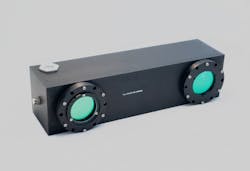Monolithic optics and optical system integration: Meet Itai Vishnia, CEO of PLX
Itai Vishnia began his career at Technion-Israel Institute of Technology (Haifa, Israel), where he studied optomechanical engineering. During the last two years of his schooling, he had the opportunity to join a startup company called Duma Optronics as a pre-engineer. At the time (1992-1996), Duma Optronics only worked on laser analysis products and had just seven employees. This opportunity introduced him to the engineering behind the theory and taught him about economy of scales. Vishnia attributes his success in school and his out-of-the-box thinking to the experience he gained while working at the startup.
After working for Duma Optronics for a couple of years, Vishnia joined the PLX team in 1996 as a junior engineer. Within three years, he was promoted to operations manager. At the time, PLX lacked modern manufacturing operations, which Vishnia describes as “a Home Depot type of setup: a big warehouse, but not in line with a high-precision optical assembly company.” He saw this as an opportunity to improve production capabilities and implement a total quality management strategy.
Vishnia was then offered a partner position and promoted to chief operating officer. As COO, he was responsible for developing the PLX proprietary monolithic optical structure technology—monolithic integration for high reliability and harsh environments. The team accomplished this task by taking advantage of the invariant optics that PLX excels in and combining it with the complex assembly of other compatible technologies. The main challenge was finding a technology that could withstand harsh environments, perform with stability, and promote longevity. Vishnia and his team came up with this innovative “sandwich” technology, which resulted in multiple patents.PLX’s past
When Vishnia first joined PLX, the company had approximately 20 employees, and its market was predominantly commercial. Famous for its retroreflector, PLX had two legacy programs for defense and a small annual space program. The company was limited to components rather than instrumentation, assemblies, or systems. But that soon changed after the telecom bubble burst of the early 2000s. While the burst did not directly impact PLX, it had a substantial effect on other companies. During this time, PLX’s contract with HP suddenly declined from $3 million to $0 within the span of less than a year.While PLX had a solid core technology, it was not being materialized properly. These combined factors prompted the team to shift from manufacturing components that require a high-volume mindset to manufacturing products for high reliability and a long lifespan. Surprisingly, this transition was less about instrumentation and more about overcoming the commodity barrier, the idea that PLX was just the commodity supplier.
To achieve this goal, PLX developed monolithic optical structure technology (M.O.S.T.), a breakthrough that enabled the company to start working with high-level assemblies and the integration of other technologies. The company has since expanded to support multiple applications, providing solutions to companies like NASA and Lockheed Martin. Vishnia notes that one of the best days from the last 20 years was when he made the monolithic optical structure technology invariant. This achievement, combining stability and accuracy with self-alignment, opened the door to the appealing plug-and-play market. For Vishnia, however, the most important contributor to the success of the company is having a “smart group of people around who really value and are excited about the future of PLX’s technologies.”
PLX today
PLX now provides optical instrumentation for aerospace and defense technologies. The company focuses on providing solutions beyond the traditional precision optics of the past by combining PLX’s M.O.S.T. technology with its precision beam-steering active optics, electronics, and systems.
PLX offers advanced products within emerging markets, such as precision tracking and industrial metrology—the company is far more diversified than when it first started. It has also grown to 50 employees and wants to further enhance its engineering team. The company works with many contractors—the remote nature of the pandemic economy enabled PLX to hire employees from all over the world.
While PLX’s main focus is accelerated organic growth, the company wants to acquire additional capabilities and enter new markets. In late 2020, PLX acquired Reflex Imaging, a company focused on laser tracking technology. This investment introduced PLX to potential customers in the active optics and industrial metrology markets. PLX is also in the process of acquiring a company with assets benefiting the automotive industry—more news to come! Vishnia values existing technologies and wants to partner and collaborate with companies that have good synergy with PLX’s strategy and technologies. During the next few years, PLX’s focus will be to further enhance the engineering team, grow through acquisitions, and improve its photonics capabilities.
Aerospace and defense applications
Within the aerospace industry, PLX targets applications such as free-space communications, laser-based communications, and LiDAR. Vishnia believes the satellite communication market, where alignment and fast-tracking are dependent on light and not electronics, is most compatible with PLX’s laser-tracking and M.O.S.T. technologies. Historically, this market has been very low volume (sometimes with high margins). During the past few years, however, the satellite communications market has seen a dramatic increase in volume. Vishnia says this is a great opportunity for PLX, with its monolithic technology, to work with companies looking to grow in volume.
One recent notable collaboration involving PLX is with the European Space Agency (ESA) for their Meteosat Third Generation (MTG) project, which was launched in December 2022. MTG is a series of next-generation meteorological satellites that will provide crucial weather and climate data for Europe and Africa. MTG consists of six satellites—four imaging and two sounding satellites. PLX provided a pair of 101 mm clear aperture beryllium retroreflectors for the interferometer of the Infrared Sounder. Beryllium was chosen for its low weight and high stiffness, both of which are important as the mirror position is modulated in the interferometer.
Future opportunities
PLX is known for its accurate control of light, high-quality measuring capabilities, and alignment of different optical instruments—endless possibilities and applications are available. In the future, Vishnia wants to see PLX begin to enter the communications, automotive, data storage, and artificial intelligence markets—all of which rely on photonics. Companies like PLX, which enable higher performance, will be the core to providing faster and more accurate products to these industries. The business advantage comes in the form of volume maximization.
PLX consistently pushes the limits of Boresighting technology, which significantly enhances targeting capabilities. This technology employs PLX's proprietary high-accuracy beam delivery system that can be customized to suit any application. Even under the most extreme levels of vibration and shock, such as those experienced during helicopter flight or battlefield conditions, PLX's Boresighting systems operate with extreme stability, ensuring maximum performance in harsh environments.
PLX bolstered their capabilities in active optics with their innovative Beam Steering Technology, which combines micro-electromechanical scanning mirrors (MEMS) and their M.O.S.T technology to deliver unmatched performance and accuracy in laser scanning systems for targeting and metrology applications.
Looking forward, Vishnia sees PLX being more involved in developing data-storage technologies and particularly fusion technologies. There are many companies involved in achieving this mission, and multiple methods are being tested. But this is not going to be a technology that can be commercialized within two years; this is a decades-long project to create a high-power, highly stable, and low-cost technology that meets the global energy challenge. Vishnia is fully committed to the development of fusion technology and believes PLX can meet the energy challenge of tomorrow.
Vishnia offers the younger generation this advice: “Make sure you have done everything first before you direct others.” He adds that if you demand excellence from yourself, those around you will follow. Beyond rewarding loyalty and talent, Vishnia recommends early career professionals be “keenly aware of business trends” both inside and outside of one’s specific market. This strategy can help innovate an entire industry. “Know what your brand stands for and be consistent,” he says.
About the Author
Jose Pozo
Chief Technology Officer, Optica
Jose Pozo joined Optica in March 2022, and has spent more than 25 years working in photonics. He earned a PhD in quantum physics from the University of Bristol (U.K.), and an M.Sc. and B.Eng. in telecom engineering from UPNA, Spain / VUB (Belgium). Prior to joining the European Photonics Industry Consortium (EPIC) in 2015 as CTO, Jose was a Senior Photonics Technology Consultant with PNO Consultants, with some of the main accounts such as CERN, Thales, and TE Connectivity. He has worked at TNO, The Netherlands Organization for Applied Scientific Research, and as a postdoctoral researcher at the Eindhoven University of Technology in the Netherlands, where he contributed to the early development of EFFECT Photonics.
Ana Fowler
Market Research Analyst and Coordinator, Optica
Ana Fowler is market research analyst and coordinator at Optica (Washington, DC).


